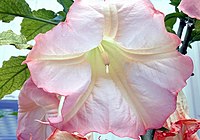
Photo from wikipedia
Abstract. Manzila I, Priyatno TP, Nugroho K, Terryana RT, Lestari P, Hidayat SH. 2020. Molecular and morphological characterization of EMS-induced chili pepper mutants resistant to Chili veinal mottle virus. Biodiversitas… Click to show full abstract
Abstract. Manzila I, Priyatno TP, Nugroho K, Terryana RT, Lestari P, Hidayat SH. 2020. Molecular and morphological characterization of EMS-induced chili pepper mutants resistant to Chili veinal mottle virus. Biodiversitas 21: 1448-1457. Chili veinal mottle virus (ChiVMV) is a major prevalent virus that potentially reduces the yield of chili pepper by more than 50% in Indonesia. Therefore, the development of a ChiVMV-resistant cultivar is necessary to ensure satisfactory chili pepper production. Mutation breeding is a promising tool available to produce virus-resistant plants via the induction of new alleles due to point mutations within the existing chili germplasm. This research was conducted to assess the genetic variation of ten promising (M6) EMS-induced mutant lines of chili pepper (Capsicum annuum L.) potentially resistant to ChiVMV by their morphological characteristics and SSR profile, as well as identify potential mutants based on agronomic traits. The ten chili pepper mutant lines used in the present study were derived from the shoot tips of a Gelora cultivar treated with 0.5% ethyl methanesulfonate (EMS) as a chemical mutagen. The performance of the respective promising chili pepper mutant lines both at a molecular and morphological level was observed. Phenotypic analysis showed that all the promising chili pepper mutant lines underwent significant morphological changes. Of these, the phenotype coefficient variation (PCV) values were higher than the genotype coefficient variation (GCV) values for all the traits observed. High heritability (h2) was found for the canopy area, length of the fruit stalk, fruit weight, fruit weight per plant, thick fruit flesh, leaf width, leaf length, and fruit storage duration. A total of 52 alleles were detected from the five polymorphic SSR loci with 5.2 average alleles/loci. A dendrogram was generated and revealed two groups with five mutants clustered separately from their parents which could be valuable for further improvement.
Journal Title: Biodiversitas
Year Published: 2020
Link to full text (if available)
Share on Social Media: Sign Up to like & get
recommendations!